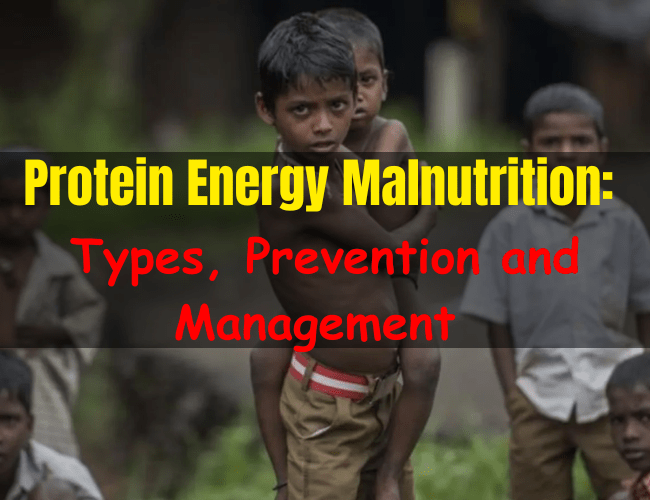Protein Energy Malnutrition (PEM): Types, Prevention and Management
Definition of Protein Energy Malnutrition (PEM):
Protein energy malnutrition describes as a range of clinico-pathological condition arising from coincidental lack, in varying proportion of protein and calories, occurring mostly in infant and young children, and commonly associated with infection.

Classification or Types of Protein Energy Malnutrition (PEM):
Types | Body weight % of international | Edema | Deficit in weight for height |
Kwashiorkor | 80-60 | Present | + |
Marasmic kwashiorkor | <60 | Present | ++ |
Marasmus | <60 | Absent | ++ |
Nutritional dwarfism | <60 | Absent | Minimal |
Underweight child | 80-60 | Absent | + |
How to Prevent Protein Energy Malnutrition (PEM)?
Preventive measures of protein energy malnutrition (PBM) according to WHO/FAO:
1. Health Promotion:
- Education & distribution of supplements to pregnant & lactating women.
- Promotion of breastfeeding.
- Weaning food – low cost & frequent feeding practice.
- Family diet improvement.
- Nutrition education- promotion of correct feeding practice.
- Improvement of family environment.
- Home economics.
- Family planning and spacing of births.
2. Specific protection:
- Child diet must contain protein & energy rich food. Such as milk, eggs, fresh fruits.
- Immunization.
- Food fortification.
3. Early diagnosis and Treatment:
- Periodic surveillance.
- Early diagnosis of any lag in growth.
- Early diagnosis and treatment of infection & diarrhoea.
- Development of supplementary feeding programme during epidemics.
- Deworming of heavily infected children.
4. Rehabilitation:
- Nutrition rehabilitation services.
- Hospital treatment.
- Follow-up care.
What Kind of People Are Mostly Affected By Protein Energy Malnutrition (PEM) and Why?
Protein energy malnutritions (PEM) is a problem of slum people because-
1. They are the vulnerable society having poverty whose intake of food never be adequate and diet doesn’t contain protein energy rich foods like milk, eggs, fresh fruits etc.
2. Infections are very common in the slum people notably diarrhea, respiratory infections, measles and intestinal worms which increase requirements for calories, proteins and other nutrients while decreasing the absorption and utilization.
3. Lack of immunization, lack knowledge about family planning and spacing of births.
4. Poor environmental conditions, large family size, poor maternal health are also contributing factors.
Management of Protein energy malnutrition (PEM):
1. Resuscitation: It includes correction of hypoglycemia and treatment for infections dehydration, electrolyte disturbances, and acidosis.
2. Start of the cure: It includes re-feeding, gradually working up the calories to 150 kcal/kg with protein about 1.5 g/kg.
3. Nutritional rehabilitation.
Factors Related to Malnutrition in Bangladesh:
Women’s education | 43% |
Health environment | 19% |
Food availability | 26% |
Women’s status | 12% |
More questions related to this article?
- What do you mean by protein energy malnutrition?
- Define protein energy malnutrition.
- Write down the classification of protein energy malnutrition.
- Classify protein energy malnutrition according to FAO/WHO.
- How will you prevent protein energy malnutritions (PEM)?
- Write down the preventive measures of protein energy malnutrition.
- What kind of people are mostly affected by protein energy malnutrition and why?
- Why slum people are more vulnerable to protein energy malnutrition?
- Describe the management of protein energy malnutrition.
- What are the factors related to malnutrition in Bangladesh?

Maria Khatun Mona is a Founder and Editor of Nursing Exercise Blog. She is a Nursing and Midwifery Expert. Currently she is working as a Registered Nurse at Evercare Hospital, Dhaka, Bangladesh. She has great passion in writing different articles on Nursing and Midwifery. Mail her at “maria.mona023@gmail.com”
